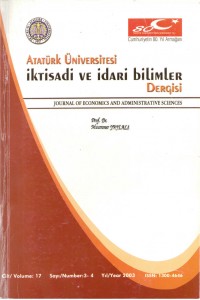İÇSEL BÜYÜMENİN KAYNAKLARI
Öz
Özet: Temel girdileri işgücü, ve fiziki sermaye olan neoklasik büyüme
modeline (Solow-Swan) göre, azalan verimler yasası gereği gelişmiş ülkeler zamanla
durgun duruma girmekle ve gelişmekte olan ülkeler onian yakalamaktadır. Oysa
pratikte, gelişmiş ekonomiler daha istikrarlıdırlar ve büyümeye devam etmektedirler.
İçsel büyüme modelleri teori ile praîik arasındaki bu çelişkiyi bilgi, teknolojik
gelişme, beşeri sermaye, işbölümü ve uzmanlaşma. Ölçek ekonomiler, dışsalhklar ve
yayılma etkilerini içselleştirerek aşmışlardır. İçsel büyümenin kaynaklarının
tanıtıldığı bu çalışmada, beşeri sermayenin büyümeye katkısı, Türkiye 1963-2001
örneğinde, en küçük kareler yöntemiyle test edilmiş ve pozitif katkı bulunmuştur.
Abstract: Developed countries get into steady state and developing
countries catch up by the time according to the diminishing returns based on the neoclassical
growth models of which main inputs are labor and physical capital. In
reality developed countries are more stable on the one hand and go on developing on
the other hand. The endogenous growth models have solved this paradox between
theory and practice endogenizing the knowledge, technological change, human
capital, division of labor, scale economies, externalities and diffusion effects. In this
study, in which resources of endogenous growth is introduced, the contribution of
human capital to growth has been tested forTtirkey for the 1963-2001 period. Using
ordinary least squares method, we found that human capital has positively
contributed to growth.
Anahtar Kelimeler
Ayrıntılar
| Birincil Dil | tr;en |
|---|---|
| Bölüm | Makaleler |
| Yazarlar | |
| Yayımlanma Tarihi | 26 Kasım 2010 |
| Yayımlandığı Sayı | Yıl 2003 Cilt: 17 Sayı: 3-4 |




